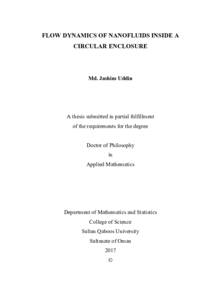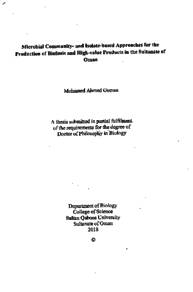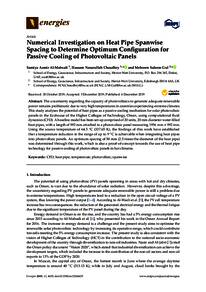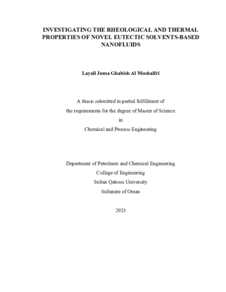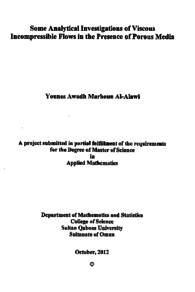Document
Flow dynamics of nanofluids inside a circular enclosure
Publisher
Sultan Qaboos University
Gregorian
2017
Language
English
Subject
English abstract
In the past decade, quick developments in nanotechnology have created quite a lot of prospect for the scientists and engineers to check up. Nanofluid is one of the amazing consequences of such progression. Nanofluids are engineered by suspending nanoparticles in traditional heat transfer fluids. Nanofluids are considered to offer important advantages over conventional heat transfer fluids. In the beginning of the thesis, the wide-ranging fundamental evolutions of nanofluids have been discoursed thoroughly by sketching out a gargantuan depiction of the diminutive biosphere of nanofluids through a brief review of some chronological foremost milestone, and potential applications and benefits of nanofluids. Also, different kinds of modeling and
very important slip mechanisms of constructing heat transfer modeling of nanofluids have been discussed comprehensively. The amazing results of research and tremendous research opportunities have been found while reviewing. As a result, new mathematical equations have been established theoretically for electrical conductivity, and thermophoretic velocity, thermal diffusion coefficient as well as the mass flux equations in nanofluid which can be used for general transport of nanofluid modeling. The result of the thermal diffusion coefficient is justified by the experimental findings. One of the main objectives of this study is to investigate the convective heat transport within enclosures numerically. Hence, the basics of convective heat transfer are demonstrated briefly along with the standard fluid dynamics equations. A broad picture of convective heat transfer models in nanofluids that had been developed theoretically in recent years has been presented. The limitations of the existing models are manifested. A new mathematical model called nonhomogeneous dynamic model of nanofluids had been developed to tackle the limitations. For solving two-dimensional incompressible natural convective flow of nanofluids in an enclosure using nonhomogeneous dynamic model, the Galerkin weighted residual technique of finite element method is employed. The detailed procedures of this method over the nonhomogeneous dynamic model are discussed and calculated for the first time. In this study, considering research scope and practical applications, the circular enclosures have been simulated using the nonhomogeneous dynamic model, and the Galerkin weighted residual finite element method. The five series of the separate problems have been set up and successively solved. The problem of two-dimensional transient convective flow and heat transfer in quarter-circular, semi-circular, semicircular annulus and horizontal cylindrical annulus shaped geometry utilizing nanofluids have been inspected. Separate boundary conditions are adopted in each problem. Also, the heat transfer performances for different types of thermal boundary conditions have been examined. The numerical treatment of the singularity at the hot and cold junction has been studied. Different types of nanofluids have been considered for the analysis. The problem of convective heat transport within quarter-circle and horizontal cylindrical annulus has been investigated along with the oriented applied magnetic field. Different shapes of the thermal boundary of the geometry for the heat transfer performance have been analyzed. The effects of the sizes, shapes and amount of nanoparticle in the suspension and different pertinent parameters of the problem such as the thermal Rayleigh number, the solutal Rayleigh number, Hartmann number, magnetic field inclination angle have been analyzed. Comparisons of heat transfer enhancement are made with the numerical as well as the experimental data available in the literature. The results are displayed in terms of streamlines, isotherms, isoconcentrations, and the local and average Nusselt numbers. The results show that 1-10 nm size nanoparticles are uniform and stable in the suspension within the quarter-circular and semi-circular enclosure while 1-20 nm size nanoparticles are stable in an annulus shaped geometry. The external magnetic field and its direction control the flow pattern of nanofluid significantly. The average Nusselt number increases significantly, as magnetic field inclination angle, and Rayleigh number increases while it decreases with the increase of magnetic field parameter. The average Nusselt number increases significantly with the increase of the nanoparticle volume fraction as well as with different shape factors of nanoparticles, whereas it decreases remarkably with the increase of nanoparticles diameter. The dissemination of temperature gradient magnitude with respect to the solid volume fraction is reciprocally proportional to the dissemination of local Nusselt number. It is also found that the inner shape of the annulus significantly affects the thermal flow as well as the Nusselt number Finally, the thermal instability analysis for the natural convective heat transport in a horizontal nanofluid filled layer using nonhomogeneous dynamic model has been investigated. The solutions with respect to the wide-ranging parameters of the problems in the current study are tested whether they are stable or unstable. It is found that the system is eventually stable for the increasing values of thermal Rayleigh number and solutal Rayleigh number. The higher wave number assists the system to remain stable. Adding nanoparticles to base fluid increases the stable region of the system. The heat transfer of the system is unstable initially in a small period of time, and then it becomes stable in rest of times
Description
Thesis
Member of
Resource URL
Arabic abstract
لقد ساھمت التطورات السريعة التي شھدھا علم تقنية النانو في العقود الماضية في فتح آفاقًا واسعة أمام العلماءوالمھندسين للبحث في ھذا المجال، وتعد الموائع النانوية واحدةً من النتائج المذھلة المرتبطة بھذه التطورات. ويتم إنتاج الموائع النانوية من خلال إضافة جسيمات نانوية إلى الموائع التقليدية التي تدعم الانتقال الحراري، وتعتبر الموائع النانوية قادرة على توفير مزايا إضافية للانتقال الحراري مقارنة بالموائع التقليدية. وقد تم في بداية ھذا البحث مناقشة التطورات الأساسية للموائع النانوية بشكل واسع ودقيق من خلال استعراض ھذه التطورات وفق ترتيبھا الزمني واستعراض التطبيقات والفوائد المھمة للموائع النانوية. كما تم استعراض مناقشة مكثفة للنماذج الرياضية المختلفة وآليات انزلاق المھمة المستخدمة في صياغة نماذج انتقال الحرارة للموائع النانوية. وقد أسفرت عملية البحث في التطورات التي شھدتھا الموائع النانوية عن وجود نتائج قيمة مع وجود فرص عديدة للبحث في ھذا المجال. وبناء عليه، فقد تم صياغة معادلات رياضية جديدة للموصلية الكھربائية، وسرعة الناقلية الحرارية، ومعامل تدفق الحرارة ومعدل تدفق الكتلة في الموائع النانوية والتي من الممكن استخدامھا في نمذجة حركة الموائع النانوية بشكل عام. وقد تم التحقق من نتيجة معامل التدفق الحراري بمقارنتھا بنتائج التجارب العملية. ونظرا لأن من أحد الأھداف الأساسية لھذه الدراسة ھو دراسة انتقال الحرارة الحملي داخل حاويات مختلفة باستخدام الطرق العددية، فقد تم تقديم عرض موجز لانتقال الحرارة الحملي إضافة الى معادلات الديناميكا الأساسية للموائع. وتم عرض النماذج الرياضية المستخدمة في انتقال الحرارة الحملي للموائع النانوية التي تم استحداثھا في السنوات الأخيرة الماضية واستعراض الفرضيات التي تحد من استخدامھا. ولمعالجة ھذه المحددات أو النواقص فقد تم استحاث نموذج رياضي جديد سمي بالنموذج الديناميكي غير المتجانس للموائع النانوية، وقد تم استخدام ھذا النموذج لدراسة تدفق الحمل الطبيعي للموائع النانوية غير القابلة للانضغاط في حاوية ثنائية البعد وقد تم حل النموذج بتطبيق أحد تقنيات الطرق العددية المعروفة بتقنية جالاركن للموزون المتبقي في طريقة العناصر المنتھية أو المحددة. وقد تم عرض طرق الحل العددية باستخدام ھذا النموذج بشكل مفصل للمرة الأولى في ھذه الدراسة، وبعد أن تم أخذ مجال البحث وتطبيقاته العملية بعين الاعتبار، تمت محاكاة حركة الموائع النانوية في حاوية دائرية باستخدام النموذج الديناميكي غير المتجانس وباستخدام تقنية جالاركن للموزون المتبقي المستخدمة في طريقة العناصر المحددة، حيث تمت دراسة خمس قضايا منفصلة في ھذا المجال وقد تم حلھا بنجاح. وتحديدا تم دراسة التدفق الحملي العابر والانتقال الحراري للموائع النانوية في حاويات ھندسية ثنائية البعد وھي شكل ھندسي ربع دائري، ونصف دائري، وطوق نصف دائري وطوق أسطواني أفقي. كمت تمت دراسة تأثير المجال المغناطيسي في بعض الحالات. وتم أيضا دراسة الانتقال الحراري في ظل وجود ظروف حراريةمختلفة على حدود الحاويات الھندسية. كما دراسة تأثير حجم وشكل وكمية الجسيمات النانوية لإضافة إلى تأثير(Hartmann Number) وعدد ھارتمان ،(Rayleigh Number) العوامل الفيزيائية المختلفة مثل عدد ريليه وتأثير زاوية ميل المجال المغناطيسي. وتم مقارنة نتائج الدراسة فيما يتعلق بتعزيز الانتقال الحراري بالنتائج السابقة التي تم الحصول عليھا باستخدام الطرق العددية أو من خلال التجارب العملية. كما تم عرض النتائج المتعلقة بالخطوط الانسيابية للسرعة وخطوط تساوي الحرارة وخطوط تساوي التركيز وقيم أرقام نشلت المحلية والمتوسطة. (Nusselt Number)10 نانومتر تكون منتظمة وثابتة في المعلق داخل – وقد أظھرت نتائج الدراسة أن الجزيئات النانوية بحجم 1
20 نانومتر – الحاويات ذات الشكل الھندسي الربع دائري أو النصف دائري، بينما الجزيئات النانوية بحجم 1 تكون ثابتة في الأشكال الھندسية ذات الطوق، كما أظھرت النتائج أن المجال المغناطيسي الخارجي واتجاھه يتحكمان في نمط تدفق الموائع النانوية بشكل ملحوظ وأن متوسط رقم نشلت يزداد بشكل ملحوظ بزيادة كل من ونسبة الجزيئات النانوية، بينما يتناقص بزيادة (Rayleigh Number) زاوية المجال المغناطيسي ورقم ريليه كل من المجال المغناطيسي وقطر الجزيئات النانوية. وكذلك انتثار قيم تغير الحرارة بالنسبة لنسبة حجم الجزء المحلي. وأظھرت النتائج أيضا أن الشكل (Nusselt number) الصلب يتناسب عكسيا مع انتثار قيم رقم نشلت الداخلي للطوق الھندسي يؤثر بشكل كبير على تدفق الحرارة وعلى رقم نشلت. وفي نھاية ھذه الدراسة، تم تحليل الثبات أو الاستقرار الحراري لانتقال الحمل الحراري الطبيعي في طبقة موائع نانوية أفقية باستخدام النموذج الديناميكي غير المتجانس، حيث تمت دراسة مدى ثبات واستقرار نتائج الدراسة في ظل وجود عوامل متعددة اشتملت عليھا القضايا الفيزيائية المطروحة في الدراسة. وأظھرت نتائج التحليل استقرارSolutal ) وقيم ريليه المذابة (Thermal Rayleigh Number) النتائج مع ازدياد قيم ريليه الحرارية كما أن القيم الموجية العالية تساعد على بقاء النتائج مستقرة، وأن إضافة جزيئات نانوية ،(Rayleigh Number للسائل الأساس يزيد من منطقة الثبات أو الاستقرار، كما أظھرت النتائج أن عملية انتقال الحرارة تكون بداية غير مستقرة لفترة قصيرة من الزمن ومن ثم تصبح مستقرة مع مرور الوقت
.
.
20 نانومتر – الحاويات ذات الشكل الھندسي الربع دائري أو النصف دائري، بينما الجزيئات النانوية بحجم 1 تكون ثابتة في الأشكال الھندسية ذات الطوق، كما أظھرت النتائج أن المجال المغناطيسي الخارجي واتجاھه يتحكمان في نمط تدفق الموائع النانوية بشكل ملحوظ وأن متوسط رقم نشلت يزداد بشكل ملحوظ بزيادة كل من ونسبة الجزيئات النانوية، بينما يتناقص بزيادة (Rayleigh Number) زاوية المجال المغناطيسي ورقم ريليه كل من المجال المغناطيسي وقطر الجزيئات النانوية. وكذلك انتثار قيم تغير الحرارة بالنسبة لنسبة حجم الجزء المحلي. وأظھرت النتائج أيضا أن الشكل (Nusselt number) الصلب يتناسب عكسيا مع انتثار قيم رقم نشلت الداخلي للطوق الھندسي يؤثر بشكل كبير على تدفق الحرارة وعلى رقم نشلت. وفي نھاية ھذه الدراسة، تم تحليل الثبات أو الاستقرار الحراري لانتقال الحمل الحراري الطبيعي في طبقة موائع نانوية أفقية باستخدام النموذج الديناميكي غير المتجانس، حيث تمت دراسة مدى ثبات واستقرار نتائج الدراسة في ظل وجود عوامل متعددة اشتملت عليھا القضايا الفيزيائية المطروحة في الدراسة. وأظھرت نتائج التحليل استقرارSolutal ) وقيم ريليه المذابة (Thermal Rayleigh Number) النتائج مع ازدياد قيم ريليه الحرارية كما أن القيم الموجية العالية تساعد على بقاء النتائج مستقرة، وأن إضافة جزيئات نانوية ،(Rayleigh Number للسائل الأساس يزيد من منطقة الثبات أو الاستقرار، كما أظھرت النتائج أن عملية انتقال الحرارة تكون بداية غير مستقرة لفترة قصيرة من الزمن ومن ثم تصبح مستقرة مع مرور الوقت
.
.
Category
Theses and Dissertations

